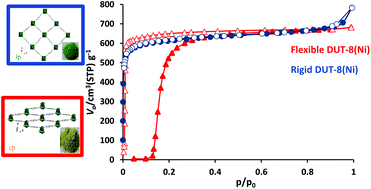Tailoring adsorption induced phase transitions in the pillared-layer type metal–organic framework DUT-8(Ni)†
Abstract
Tailoring the characteristics of gating transitions in the porous network, Ni2(ndc)2dabco (ndc = 2,6-naphthalenedicarboxylate, dabco = 1,4-diazabicyclo[2.2.2]octane), also termed DUT-8(Ni) (DUT = Dresden University of Technology), was achieved by systematically adjusting the critical synthesis parameters. The impact of the starting composition and solvent mixtures in the synthesis was found to critically affect the guest-response properties of the obtained materials. A comprehensive set of physical characterization methods, namely thermal analysis, 1H NMR of digested crystals, solid state 13C NMR, PXRD, SEM, IR and Raman spectroscopy shows that the crystallite size is a crucial factor, determining the differing characteristics such as “gate pressure” and adsorption capacity in the guest-responsive switching behaviour of DUT-8. Crystallites smaller than 500 nm in size retain the open form after removal of the guest molecules resulting in typical “Type Ia” isotherm, whereas crystallites larger than 1 μm transform into the “closed pore” form and therefore can show a characteristic “gate opening” behaviour during gas adsorption. The particle size distribution of DUT-8(Ni) can be tailored by changing the synthesis conditions and consequently the slope of the isotherm at the “gating step” is affected. The in depth analysis of synthesis conditions and switching behaviour is an important step towards a better understanding of the fundamental principles responsible for guest responsive porosity switching in the solid state.



 Please wait while we load your content...
Please wait while we load your content...